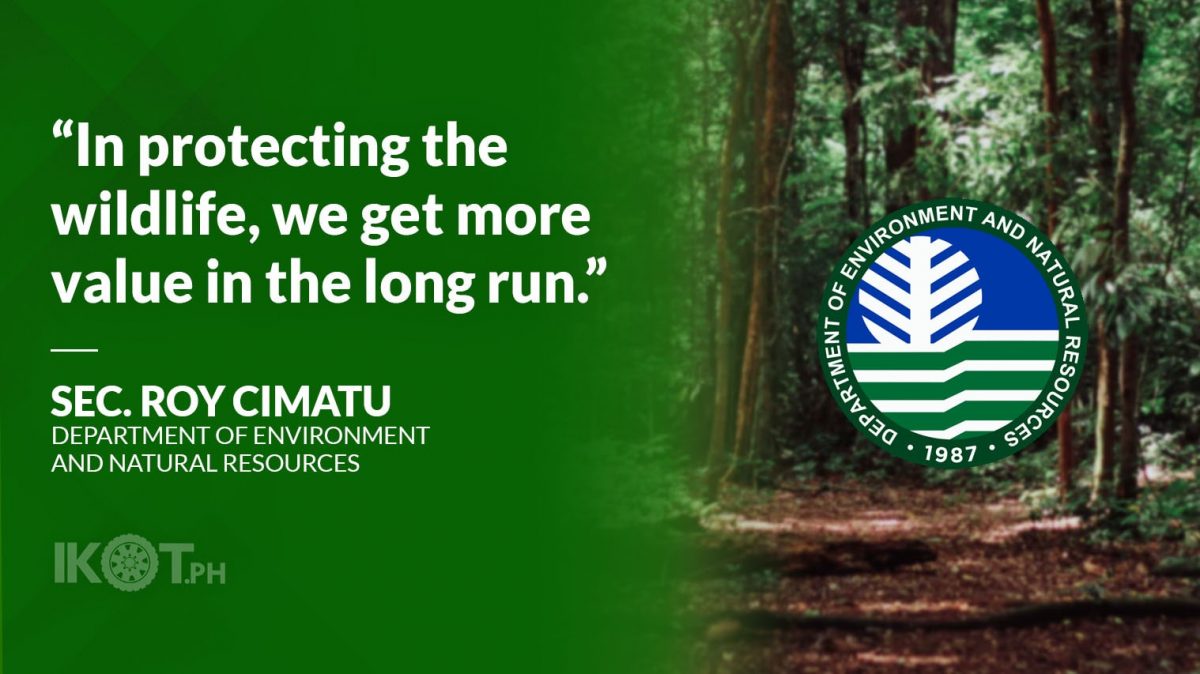Department of Environment and Natural Resources (DENR-BMB) has conducted an economic valuation study of threatened species to bring greater appreciation and attention to the economic benefit of wildlife conservation.
DENR Secretary Roy Cimatu is optimistic that the result of the study will allow “more people to be inspired in conserving and protecting our wildlife.”
“We hope that in popularizing the findings, we can entice more Filipinos to think about the long-term benefits of our wildlife such as marine turtles and blue-naped parrots, and not just short-time gains,” Cimatu said.
The study, which was conducted under the DENR-Asian Development Bank (ADB)/Global Environment Facility (GEF) Project on Combating Environmental Organized Crime in the Philippines, aims “to recognize the bigger picture,” as the protection of wildlife not only keeps ecosystems balanced, but eventually benefits human well-being.
Environmental economist and study leader Dr. Agustin Arcenas said “the economic valuation of resources is vital in monitoring whether steps to protect these resources are effective, as well as evaluating the efficiency of projects and programs geared toward managing the resources, especially in situations where no other feasible metric currently exists.”
“One marine turtle is projected to have an economic use value of P4.8 million.”
Based on the DENR-ADB/GEF study, one marine turtle is projected to have an economic use value of P4.8 million (estimated $95,900) throughout its 57-year lifetime.
This is based on its ecological role in coastal and marine ecosystems (P900,000 per turtle) and on the tourism value it generates (P3.90 million per turtle).
Meanwhile, the annual use-value of the entire population of the Philippine marine turtle, which is conservatively estimated at 7,294 individuals by the DENR-BMB, ranged between P2.89 billion and P3.19 billion ($57.88-63.85 million) per year.
The study also showed that the blue-naped parrot (Tanygnathus lucionensis) is estimated to have an economic use value of P186,000 ($3,700) throughout its six-year lifetime.
This is based on its trade value and tourism value (P5,000/blue-naped parrot when combined) and its ecological role in forest ecosystems (P181,000/blue-naped parrot).
The entire Philippine parrot population was estimated at 8,500 individuals, according to wildlife conservation group Katala Foundation. Its annual use value ranged between P36.23 million and P295.19 million ($724,500-5.90 million) per year.
Complementing the study findings, a willingness to pay survey was conducted in Cebu and Manila by the DENR-ADB/GEF Project to estimate the non-use value of marine turtles and blue-naped parrots.
It amounted to an annual value of P9.30 billion for the Philippine marine turtle population and P33.38 billion for the local blue-naped parrot population.
This is in stark contrast to the traded value of one blue-naped parrot, which is only P5,000 (estimated at $100).
The buying price per blue-naped parrot in Brgy. Buliluyan, Bataraza town in Palawan, is even lower at only P200 ($ 4.1), the study pointed out.
“This just shows that when protecting the wildlife, we get more value in the long run,” the environment chief said.
The DENR Administrative Order No. 2019-09 on the updated list of Philippine threatened fauna and their categories classifies the hawksbill turtle (Eretmochelys imbricata) and leatherback turtle (Dermochelys coriacea) as “critically endangered” while the loggerhead turtle (Caretta caretta), Green turtle (Chelonia mydas) and olive ridley turtle (Lepidochelys olivacea) as “endangered.”
The same Department Order classifies the blue-naped parrot as “critically endangered.”
Marine turtles and the blue-naped parrot are also listed in the Convention on International Trade in Endangered Species of Wild Fauna and Flora (CITES) Appendices, affording different levels of protection from over-exploitation.
They are likewise included in the International Union for the Conservation of Nature (IUCN) Red List of threatened species.
“The economic valuation study will support efforts to amend the 20-year-old Wildlife Act.”
DENR-BMB Wildlife Resources Division OIC chief Theresa Tenazas explained that the economic valuation study will “support efforts to amend the 20-year-old Wildlife Act.”
“The proposed Revised Wildlife Resources Conservation and Protection Act of 2021, which was filed by Senators Cynthia Villar and Migz Zubiri, aims to increase penalties to up to 20 years of jail time with maximum fines of P2 million or twice the value for traded species,” Tenazas said.
Cimatu said the DENR is looking forward to conducting more studies on economic valuation for other species of wildlife in the coming years.

